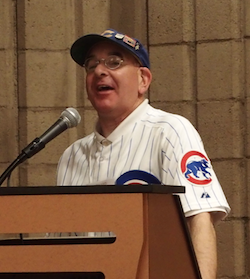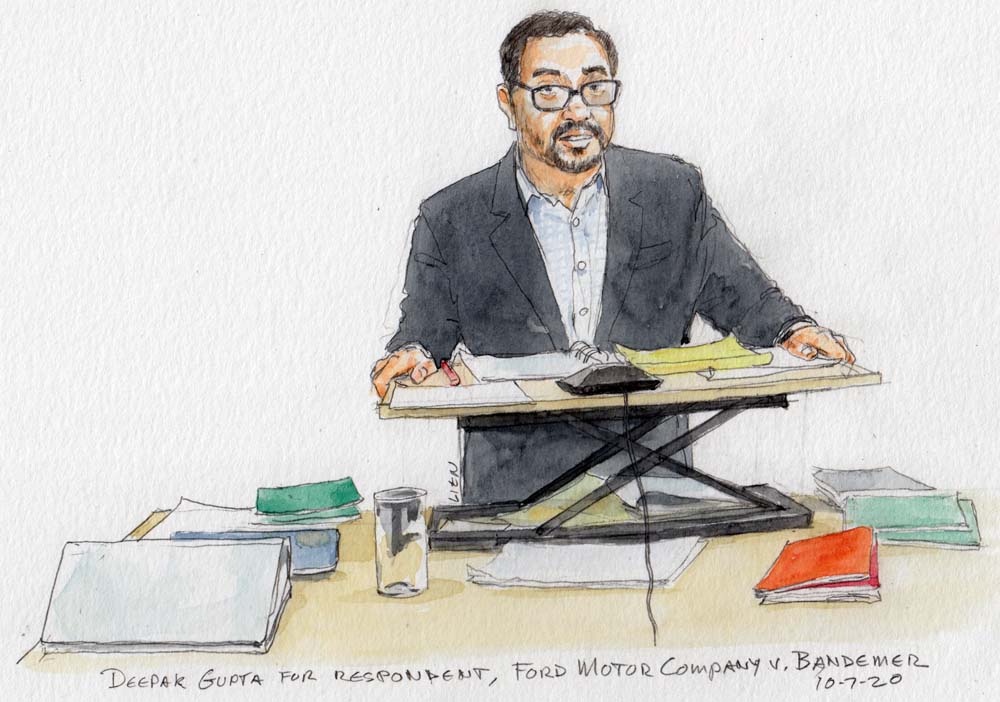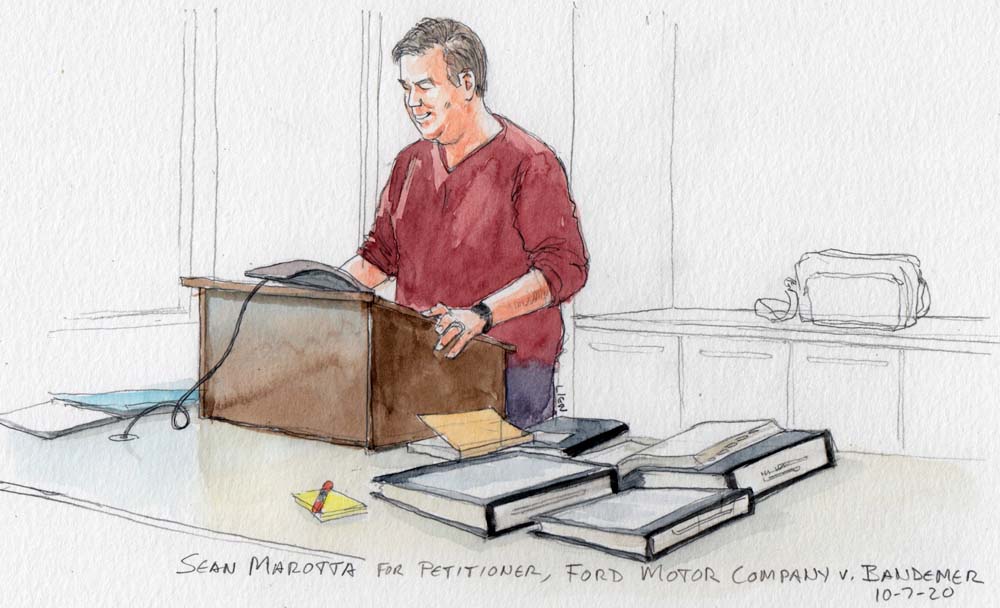Argument analysis: Due process, causation and stopping points for a 1945 doctrine in a 2020 world

on Oct 9, 2020 at 12:57 pm

Attorneys and justices explored competing causation standards and competing understandings of due process on Wednesday during oral argument in Ford v. Montana Eighth Judicial District (consolidated with Ford v. Bandemer). The cases present a question of personal jurisdiction: whether individuals injured in automobile accidents involving Ford cars can sue Ford in the states in which the accidents took place (Montana and Minnesota) if Ford regularly sells, ships and markets cars in those states but manufactured and sold the specific cars involved in the accidents in other states.


Sean Marotta, for Ford, and Deepak Gupta, for plaintiffs, phone in for arguments (Art Lien)
Arguments for Ford
Sean Marotta argued for Ford. He proposed that, for a state court to exercise personal jurisdiction over Ford, the company’s contacts with the state must be the “proximate cause” of the accident and injuries sued upon. The case is controlled by the court’s 2017 decision in Bristol-Myers Squibb v. Superior Court of California, which held that selling a similar product in a state could not provide a basis for jurisdiction in that state. In BMS, the plaintiffs were Ohioans suing in California, whereas in this case, the plaintiffs are citizens of the forum states (Montana and Minnesota). But the plaintiff’s home state is irrelevant under Walden v. Fiore. Personal jurisdiction, Marotta reminded the court, protects defendants, not plaintiffs.
Chief Justice John Roberts. The chief justice proposed a hypothetical in which a car manufacturer advertised cars in all states and the ads prompted the plaintiff to purchase the car, including by highlighting the car’s safety. Marotta said advertising was in the “but-for” causal chain but was too attenuated to be the proximate cause of the accident. A plaintiff “tells the story” of an accident, and only those contacts that are part of the story — that are relevant to the substance of the story — matter for jurisdiction. Proximate cause is about the “directness” of the connections.
Justice Clarence Thomas. Thomas wondered about the lineage of the proximate-cause test and its connection to the original understanding of due process, describing a “long journey” from the court’s precedent to constitutional meaning. Marotta responded that precedent recognizes the foundational personal-jurisdiction case, International Shoe v. Washington, as consistent with the original meaning of due process, focused on the defendant’s conduct and suits arising from that conduct. Thomas proposed a hypothetical Tennessee citizen who buys a car in Roanoke, Virginia, based on internet advertising. Marotta said whether a Tennessee court has jurisdiction would depend on whether the defendant’s actions lured the plaintiff to Roanoke or whether the plaintiff found Roanoke on his own.
Justice Stephen Breyer. Breyer proposed that fairness concerns underlie personal jurisdiction and asked how having to defend in Montana and Minnesota was unfair to Ford, given its sales in both states and the likelihood that it expects to defend potential lawsuits there. But Ford does not expect to defend there on the specific products involved in these accidents, Marotta said. Moreover, the court’s rule must account not only for a national or multi-national corporation such as Ford, but for smaller manufacturers that would be burdened by litigating in foreign courts.
Justice Samuel Alito. Marotta defined proximate cause as a “sufficiently direct cause.” Alito wondered whether the distinction from BMS is the absence in that case of any connection between the plaintiffs and forum state, whereas the plaintiffs in these cases reside in the forum states. Marotta said Montana and Minnesota lack relevant connections to Ford’s conduct, because Ford designed, manufactured and sold the cars at issue outside the forum states.
Justice Sonia Sotomayor. Sotomayor questioned whether the result of Ford’s argument is that it is subject to suit only in its home state. Marotta said there could be proximate cause linking Ford to the state where the car was built or where there was an important and material sale. Sotomayor also wondered about a hypothetical defect in an airbag that had been replaced by a dealer, where there was some question whether the replacement airbag or the old sensor caused the accident. Marotta responded that the repair would create jurisdiction in the state of the repair.
Justice Elena Kagan. Kagan asked whether Ford was urging, in effect, a “first-sale rule,” in which jurisdiction lies where the manufacturer made the first sale. Marotta insisted his test was not so limited, but extended to any place with a sufficient proximate-cause link. Marotta rejected Kagan’s attempt to distinguish Walden because the defendant there had no contact with the forum state — BMS began from Walden’s premise that injury in the forum state is insufficient, then found no jurisdiction because the BMS plaintiffs did not even suffer an injury in the forum.
Justice Neil Gorsuch. Gorsuch followed Thomas to the original understanding of due process — whether that understanding means the concept of “fair play,” the “law of the land” or something else. Marotta argued that the point of specific personal jurisdiction is to not hold defendants liable for their acts occurring in another state — here, the plaintiffs would have suffered the same injuries in the same states if Ford had done nothing in Montana or Minnesota.
Justice Brett Kavanaugh. Kavanaugh wondered why Ford did not want to litigate these cases in Montana and Minnesota, given that it litigates (or expects to litigate) other cases there. Marotta discussed the problems of dealing with judges and courts in another forum, then returned to small manufacturers who, unlike Ford, might never litigate in Montana or Minnesota.
Arguments for plaintiffs
Deepak Gupta argued for the plaintiffs, although technical difficulties with his phone connection required a several-minute recess. Upon reestablishing the connection, Roberts quipped, “I assume you didn’t decide to rest on your briefs,” a comment that would have drawn a laugh during in-person arguments.
Gupta argued that jurisdiction was warranted on two facts — Ford’s product injured the plaintiffs in the forum states and Ford deliberately cultivated markets in those products in those forum states through in-state activities. Moreover, jurisdictional rules should be simple, whereas Ford’s proposed proximate-cause rule is elusive, forces plaintiffs to follow the commercial trail on individual products, and turns personal jurisdiction into a game.
Chief Justice John Roberts. Roberts worried about a hypothetical local manufacturer in Maine who advertises his products over the internet and whether he could be sued in any state. Gupta said it would depend on whether any sales to forum states were isolated or whether the manufacturer was “really injecting” his product into the forum states, such as through targeted advertisements. But that went to the first step of the personal-jurisdiction analysis — a concept known as “purposeful availment” through deliberate cultivation of the market — which was conceded in this case. Relatedness remained a distinct issue.
Justice Clarence Thomas. Thomas asked how related the defendant’s contacts must be to the forum state. Gupta said it begins where BMS left off — where the claim is “affiliated” with the forum state because there was some occurrence there. He said relatedness involves two questions — the state’s interest in the controversy and whether the defendant incurred some “reciprocal legal obligations” because of its in-state contacts. That happens, Gupta said, when a defendant such as Ford sells the same product in the state and that product injures someone.
Justice Stephen Breyer. Breyer wondered how much business a defendant must do in a state, how similar the in-state product must be to the out-of-state product, and how much of the product must be sold in the forum state. Gupta said the court must ask if the plaintiff was injured in the forum state, then determine whether the product involved is the same make, year or model as those sold in-state. He emphasized that many cases, including these, involve mass-produced products, without differences across state lines. And companies could choose which products to sell in which states.
Justice Samuel Alito. Alito picked up that line, asking about bespoke or limited-quantity products, which Gupta said required targeting (a purposeful-availment issue). Alito wondered whether the entire personal-jurisdiction mechanism was antiquated, applying 1945 (the year of International Shoe) standards and 1945 conceptions of fair play to a completely different 2020 world of the internet; he asked whether Gupta had a bigger solution to the problem. Gupta conceded that the doctrine did evolve in the early-to-mid 20th century as markets changed but then entered a period of relative stasis. While acknowledging that stasis, Gupta pointed to Breyer’s concurring opinion in J. McIntyre Machinery v. Nicastro (which Alito joined), urging the court not to write broad rules or paint with too broad a brush.
Justice Sonia Sotomayor. As she did with Marotta, Sotomayor posited a case about a defective airbag in a specific model of car. She wondered if there would be personal jurisdiction if the defendant did not sell that model in the state, but sold other models containing the same airbag in the state. Gupta said defendants can decide what products to sell in different states, but it must be “objectively discernible to everyone” that the in-state and out-of-state products are different. The test focuses on the finished product not what is in the “guts” of the car.
Justice Elena Kagan. Kagan asked about a hypothetical special pickup truck sold only in the Southeast and taken to the state of Washington by the plaintiff; Gupta said that would fail his proposed test. But it might be different if the special truck were sold primarily in the Southeast but also in small amounts through a single Washington dealer, he said. Kagan suggested that personal jurisdiction is about federalism as much as fairness; Gupta agreed and said federalism weighs in the plaintiffs’ favor here, given the states’ interest in protecting their citizens, which is why 40 states submitted an amicus brief supporting the plaintiffs.
Justice Neil Gorsuch. Gorsuch wondered about the same problem as Sotomayor — whether the focus is on the complete product or on components. Gupta reiterated that it must be the objectively discernible final product, rejecting a test that turns on components. He also rejected the suggestion that his test blurred the line between specific and general jurisdiction — nothing could be more specific than the place of the injury and the sale of the specific make, model and year of the product in the state. Gorsuch said that although Gupta rejected a focus on components, the attorney in the next case might not.
Justice Brett Kavanaugh. Kavanaugh wanted Gupta to separate purposeful availment from relatedness and to ensure that the establishment of the former did not establish the latter whenever the injury occurs in the forum state. Gupta agreed that it does not, saying that the court must look first at what the defendant did to target the market (purposeful availment), then whether the injury occurred in the forum state, and then whether the plaintiff’s claim fell within the scope of the legal obligations to which the defendant subjected itself in the forum (relatedness).
Ford’s rebuttal
Marotta made three points on rebuttal. First, Ford’s proposed proximate-cause test is grounded in common law, easily applied in lower courts, and applicable to all types of cases. Second, the defendant’s sale of a sufficient quantity of the same product in the forum state, along with the plaintiff’s presence in that state, is insufficient to establish jurisdiction under BMS. Finally, a state’s interest in the case cannot provide the basis for jurisdiction; rather, even when the state has a high interest in the case and the defendant would suffer no inconvenience by litigating there, the “due process clause, acting as an instrument of interstate federalism,” may divest state courts of jurisdiction.
[Disclosure: Goldstein & Russell, P.C., whose attorneys contribute to this blog in various capacities, is counsel on an amicus brief in support of the respondents in this case. The author of this post is unaffiliated with the firm.]


